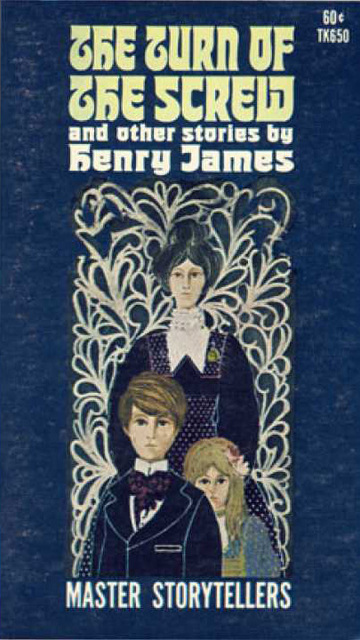The Turn of the Screw
by Henry James
Review by Katie Rose

The Turn of the Screw by Henry James takes
you into the realm of horror. This is not like most modern day horrors,
however. It lacks all the blood, gore, and cheap frights that characterize most
horror stories. It is more old-fashioned.
Well it should be! It was, after all, published in 1898. Usually I hate
horror stories. I scare really easy and my over active imagination can keep me
up for weeks with images inspired by whatever horror story I have foolishly
allowed myself to intake. There was none of that with this story. This is
perhaps because this novella is more psychological than murderous.
Note: I would not recommend this book for children. There
are a lot of adult themes in it that I would not consider appropriate.
The
main character is a young governess who has just taken up a new position at an
estate which has recently become open due to the mysterious death of her
predecessor. Her young wards, a girl named Flora and a boy named Miles, are
seemingly delightful and innocent children. This is the governess’ first job,
and she is determined to be the hero of these children’s lives.
The
great villains of the story are ghosts….maybe. This is one of those horror
stories where the reader is constantly wondering, is this really happening?
There is a very real possibility that the governess is insane. With stories
like these, it is important for the reader to question everything. The story is
told through the perspective of the governess, who is an unreliable narrator.
Everything is never as it seems in this story, or is it? Another piece of
advice for reading this story is to see sex everywhere. I know that sounds
weird, and trust me I am not one of those people who reads sexually undertones
into everything, but this is how the story is meant to be read. Because of the
era it was written in, James had to use euphemisms and innuendo to tell this
story. He could never actually come right out and say what he meant. What Henry
does with these social limitations, though, is genius. He uses this constraint
to let the reader’s imagination run wild. Are things as awful as they appear? I
don’t know. I have read this book three times and I still don’t know what I
believe happened.
As I
said before, there is no pointless gore or scream-out-loud moments. It is a
deeply psychological story that mostly takes place within the mind of a woman
on the edge of sanity. The governess, although she is never given a name, is
complicated and deeply flawed. Both her motivation and mental stability can be
questioned throughout the book. Out of the six characters in this story four
are female. There are no scenes of brutal murder or sexual violence against any
of them, although the reader can read those elements into the story if they
chose, (although I think it is a bit of a stretch to do so).
In the
end, I would say this book is not for everyone. If psychological horrors are
not your thing, then you can skip it. If you enjoy that genre, however, then I
would say this is a great book that is deliciously complicated and layered. It
features a mostly female cast of characters, and it is very readable at only
155 pages (in the version I own at least). The language, being written in the
late 1800’s, can take a chapter or two to get used to, but it is not difficult.
As I stated before, I am not a fan of horror but I enjoyed this book immensely.
Final recommendation? Give it a chance! It may surprise you!



No comments:
Post a Comment